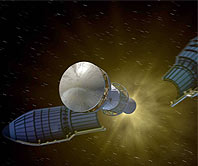|
On January 3, 2004, a strange sight unfolded on the planet Mars. Above a
vast, dry lake bed south of the martian equator, a conical vehicle
parachuted toward the surface. Then, just before touch down, it was
enveloped by a gigantic protective airbag allowing the craft to bounce safely
to a stop. Inside was Spirit, the most sophisticated rover ever launched from
Earth. "MARS Dead or Alive," which originally aired just hours after Spirit landed on the red
planet, covers this mission in depth.
The program's behind-the-scenes look at the construction of Spirit and its
twin, Opportunity, includes a special up-to-the-minute segment with the latest news
from Mars as of January 3, 2004—to learn if Spirit is ready to
undertake the most comprehensive search for evidence of liquid water ever
attempted on Mars.
NOVA spent months documenting the tension-filled process of building, testing,
final checkout, and launch of a pair of spacecraft that are designed not only
to be remote-controlled field geologists but to perform in a demanding
environment millions of miles from Earth. As the program shows, unexpected
problems with designs for the parachute and airbags almost scuttled the
mission, and a potentially catastrophic electronic problem on Spirit didn't
turn up until the vehicle was completely inaccessible and awaiting launch.
Riding on the mission are not just the hopes of scientists seeking to answer
baffling questions about the history of Mars, but the future of NASA's Mars
exploration program itself. Twice in 1999 NASA probes arriving at Mars were
lost without a trace. One of the few recent bright spots for Mars research was
the surprising success of the experimental lander-rover Pathfinder in 1997,
which was designed to test the airbag-landing technique.
Pathfinder was spawned by a freewheeling group of young scientists and
engineers who are now back with the far more ambitious Spirit and Opportunity
vehicles, which make up what is officially called the Mars Exploration Rover
(MER) project. The MER science team is headed by planetary scientist Stephen
Squyres of Cornell University, who conceived the project with the goal of
probing the most burning questions in Mars science: Was there ever liquid water
on the Red Planet? Were conditions ever suitable for life?
Spirit and Opportunity are mobile laboratories outfitted with visible-light and
infrared cameras to scan the landscape and locate promising rocks for
investigation; a power tool to grind off the weathered surface; a microscope to
examine the interior; and two other instruments to sniff out the rock's
chemistry. (For a closer look at a MER, see Anatomy of a Rover.) In this way,
the MER team held out hope of finding evidence of the liquid water that many scientists
theorize was once abundant on Mars's surface but has since vanished.
The landing sites were chosen for their strong signs of a wet past.
Spirit is now on site in Gusev Crater, a possible former lake, while Opportunity
has been exploring Meridiani Planum, where minerals have been
detected that normally form in the presence of water. And where there's water,
there may have been life. The ultimate goal of Spirit and Opportunity is to shed light on this intriguing possibility and
perhaps pave the way for the most versatile explorers of all—humans.


|


The spacecraft housing one of the rovers heads to Mars in a NASA animation.
|
|
|

